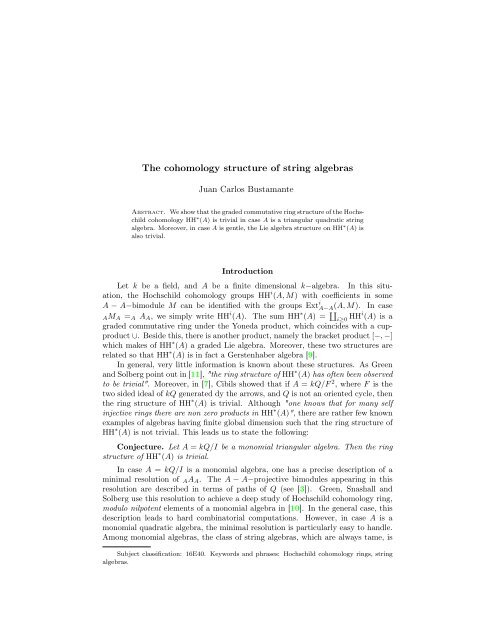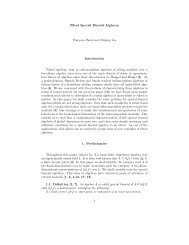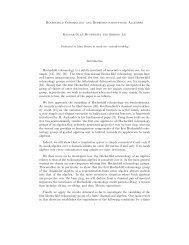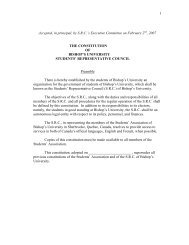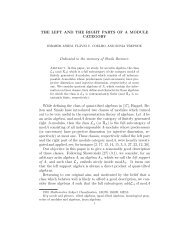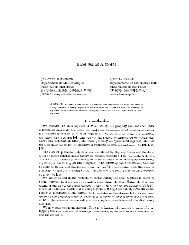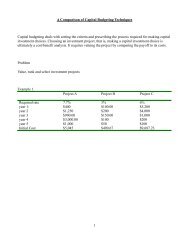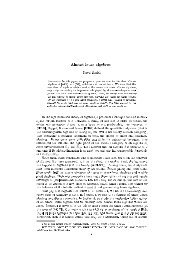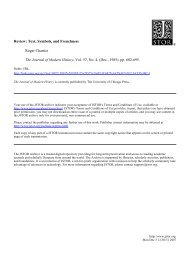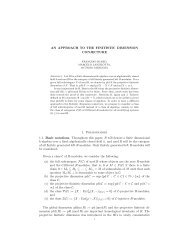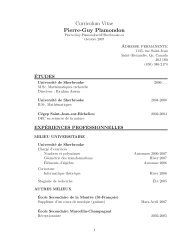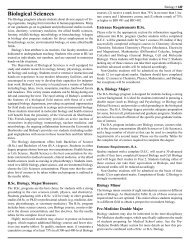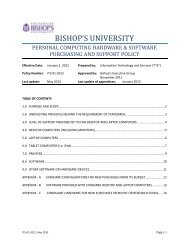The cohomology structure of string algebras
The cohomology structure of string algebras
The cohomology structure of string algebras
Create successful ePaper yourself
Turn your PDF publications into a flip-book with our unique Google optimized e-Paper software.
<strong>The</strong> <strong>cohomology</strong> <strong>structure</strong> <strong>of</strong> <strong>string</strong> <strong>algebras</strong><br />
Juan Carlos Bustamante<br />
Abstract. We show that the graded commutative ring <strong>structure</strong> <strong>of</strong> the Hochschild<br />
<strong>cohomology</strong> HH ∗ (A) is trivial in case A is a triangular quadratic <strong>string</strong><br />
algebra. Moreover, in case A is gentle, the Lie algebra <strong>structure</strong> on HH ∗ (A) is<br />
also trivial.<br />
Introduction<br />
Let k be a field, and A be a finite dimensional k−algebra. In this situation,<br />
the Hochschild <strong>cohomology</strong> groups HH i (A, M) with coefficients in some<br />
A − A−bimodule M can be identified with the groups Ext i A−A(A, M). In case<br />
AM A = A A A , we simply write HH i (A). <strong>The</strong> sum HH ∗ (A) = ∐ i≥0 HHi (A) is a<br />
graded commutative ring under the Yoneda product, which coincides with a cupproduct<br />
∪. Beside this, there is another product, namely the bracket product [−, −]<br />
which makes <strong>of</strong> HH ∗ (A) a graded Lie algebra. Moreover, these two <strong>structure</strong>s are<br />
related so that HH ∗ (A) is in fact a Gerstenhaber algebra [9].<br />
In general, very little information is known about these <strong>structure</strong>s. As Green<br />
and Solberg point out in [11], "the ring <strong>structure</strong> <strong>of</strong> HH ∗ (A) has <strong>of</strong>ten been observed<br />
to be trivial". Moreover, in [7], Cibils showed that if A = kQ/F 2 , where F is the<br />
two sided ideal <strong>of</strong> kQ generated dy the arrows, and Q is not an oriented cycle, then<br />
the ring <strong>structure</strong> <strong>of</strong> HH ∗ (A) is trivial. Although "one knows that for many self<br />
injective rings there are non zero products in HH ∗ (A)", there are rather few known<br />
examples <strong>of</strong> <strong>algebras</strong> having finite global dimension such that the ring <strong>structure</strong> <strong>of</strong><br />
HH ∗ (A) is not trivial. This leads us to state the following:<br />
Conjecture. Let A = kQ/I be a monomial triangular algebra. <strong>The</strong>n the ring<br />
<strong>structure</strong> <strong>of</strong> HH ∗ (A) is trivial.<br />
In case A = kQ/I is a monomial algebra, one has a precise description <strong>of</strong> a<br />
minimal resolution <strong>of</strong> A A A . <strong>The</strong> A − A−projective bimodules appearing in this<br />
resolution are described in terms <strong>of</strong> paths <strong>of</strong> Q (see [3]). Green, Snashall and<br />
Solberg use this resolution to achieve a deep study <strong>of</strong> Hochschild <strong>cohomology</strong> ring,<br />
modulo nilpotent elements <strong>of</strong> a monomial algebra in [10]. In the general case, this<br />
description leads to hard combinatorial computations. However, in case A is a<br />
monomial quadratic algebra, the minimal resolution is particularly easy to handle.<br />
Among monomial <strong>algebras</strong>, the class <strong>of</strong> <strong>string</strong> <strong>algebras</strong>, which are always tame, is<br />
Subject classification: 16E40. Keywords and phrases: Hochschild <strong>cohomology</strong> rings, <strong>string</strong><br />
<strong>algebras</strong>.
2 J. C. BUSTAMANTE<br />
particularly well understood, at least from the representation theoretic point <strong>of</strong> view<br />
[5]. We study the <strong>cohomology</strong> <strong>structure</strong> <strong>of</strong> triangular quadratic <strong>string</strong> <strong>algebras</strong>.<br />
After recalling some notions concerning the products in HH ∗ (A) in section 1,<br />
we establish some technical preliminary results in section 2. Finally, section 3 is<br />
devoted to state and show the main result <strong>of</strong> this work, which proves the conjecture<br />
below in the case <strong>of</strong> triangular quadratic <strong>string</strong> <strong>algebras</strong>.<br />
<strong>The</strong>orem 3.1. Let A = kQ/I be a triangular quadratic <strong>string</strong> algebra, n > 0<br />
and m > 0. <strong>The</strong>n HH n (A) ∪ HH m (A) = 0.<br />
In addition, we obtain a similar result concerning the Lie algebra <strong>structure</strong> for<br />
a particular case <strong>of</strong> <strong>string</strong> <strong>algebras</strong>, the so-called gentle <strong>algebras</strong>.<br />
<strong>The</strong>orem 3.2. Let A = kQ/I be a triangular gentle algebra, n > 1 and m > 1.<br />
<strong>The</strong>n [HH n (A), HH m (A)] = 0.<br />
1. Preliminaries<br />
1.1. Algebras. Let Q = (Q 0 , Q 1 , s, t) be a finite quiver (see [4]), and k be a<br />
commutative field. We consider <strong>algebras</strong> <strong>of</strong> the form kQ/I, where I an admissible<br />
ideal <strong>of</strong> the path algebra kQ. This includes, for instance, all basic connected finite<br />
dimensional <strong>algebras</strong> over algebraically closed fields (see [4]).<br />
While we briefly recall some particular concepts concerning bound quivers and<br />
<strong>algebras</strong>, we refer the reader to [4], for instance, for unexplained notions. <strong>The</strong><br />
composition <strong>of</strong> two arrows α 1 : s(α 1 ) t(α 1 ), and α 2 : s(α 2 ) t(α 2 ) such that<br />
s(α 2 ) = t(α 1 ) is the path α 1 α 2 , and will be denoted by α 1 α 2 : s(α 1 ) t(α 2 ).<br />
If Q has no oriented cycles, then A is said to be a triangular algebra. A two sided<br />
ideal I kQ generated by a set <strong>of</strong> paths in Q is said to be monomial. Moreover<br />
if the generators <strong>of</strong> an admissible ideal I are linear combinations paths <strong>of</strong> length<br />
2, then I is said to be quadratic. An algebra A = kQ/I is said to be monomial,<br />
or quadratic, depending on whether I is monomial or quadratic. In the remaining<br />
part <strong>of</strong> this paper, all <strong>algebras</strong> are triangular, quadratic and monomial.<br />
Among monomial <strong>algebras</strong>, the so-called <strong>string</strong> <strong>algebras</strong> [5] are particularly well<br />
understood, at least from the representation theoretic point <strong>of</strong> view. Recall from<br />
[5] that an algebra A = kQ/I is said to be a <strong>string</strong> algebra if (Q, I) satisfies the<br />
following conditions :<br />
(S1) I is a monomial ideal,<br />
(S2) Each vertex <strong>of</strong> Q is the source and the target <strong>of</strong> at most two arrows, and<br />
(S3) For an arrow α in Q there exists at most one arrow β and at most one<br />
arrow γ such that αβ ∉ I and γα ∉ I.<br />
A <strong>string</strong> algebra A = kQ/I is called a gentle algebra [2] if in addition (Q, I)<br />
satisfies :<br />
(G1) For an arrow α in Q there exists at most one arrow β and at most one<br />
arrow γ such that αβ ∈ I and γα ∈ I,<br />
(G2) I is quadratic.<br />
1.2. Hochschild <strong>cohomology</strong>. Given an algebra A over a field k, the Hochschild<br />
<strong>cohomology</strong> groups <strong>of</strong> A with coefficients in some A−A−bimodule M, denoted<br />
by HH i (A, M), are the groups Ext i A e(A, M) where Ae = A ⊗ k A op is the enveloping<br />
algebra <strong>of</strong> A. In case M is the A − A−bimodule A A A , we simply denote them
THE COHOMOLOGY STRUCTURE OF STRING ALGEBRAS 3<br />
by HH i (A). We refer the reader to [12], for instance, for general results about<br />
Hochschild (co)-homology <strong>of</strong> <strong>algebras</strong>.<br />
<strong>The</strong> lower <strong>cohomology</strong> groups, that is those for 0 ≤ i ≤ 2, have interpretations<br />
and give information about, for instance, the simple-connectedness or the rigidity<br />
properties <strong>of</strong> A (see [1, 8], for instance).<br />
Beside this, the sum HH ∗ (A) = ∐ i≥0 HHi (A) has an additional <strong>structure</strong> given<br />
by two products, namely the cup-product ∪, and the bracket [−, −], which are<br />
defined in [9] at the cochain level. <strong>The</strong> definitions are given in 1.5.<br />
1.3. Resolutions. From [6], we have a projective resolution <strong>of</strong> A over A e<br />
which is smaller that the standard Bar resolution. Let E be the (semi-simple)<br />
subalgebra <strong>of</strong> A generated by Q 0 . In the remaining part <strong>of</strong> this note, tensor products<br />
will be taken over E, unless it is explicitly otherwise stated. Note that, as E −<br />
E−bimodules, we have A ≃ E ⊕ radA. Let radA ⊗n denote the n th tensor power<br />
<strong>of</strong> radA with itself. With these notations, one has a projective resolution <strong>of</strong> A as<br />
A − A−bimodule, which we denote by K<br />
rad • (A)<br />
. . . A ⊗ radA ⊗n ⊗ A bn−1 A ⊗ radA ⊗n−1 ⊗ A bn−2 . . .<br />
A ⊗ radA ⊗ A<br />
where ɛ is the multiplication <strong>of</strong> A, and<br />
b 0<br />
A ⊗ A<br />
b n−1 (1 ⊗ r 1 ⊗ · · · ⊗ r n ⊗ 1) = r 1 ⊗ r 2 ⊗ · · · ⊗ r n ⊗ 1<br />
+<br />
ɛ<br />
A 0<br />
n−1<br />
∑<br />
(−1) j 1 ⊗ r 1 ⊗ · · · ⊗ r j r j+1 ⊗ · · · ⊗ r n ⊗ 1<br />
j=1<br />
+ (−1) n 1 ⊗ r 1 ⊗ · · · ⊗ r n .<br />
Remark. Note that since the ideal I is assumed to be monomial, radA is<br />
generated, as E − E−bimodule, by classes p = p + I <strong>of</strong> paths <strong>of</strong> Q. Moreover,<br />
since the tensor products are taken over E, then A ⊗ radA ⊗n ⊗ A is generated, as<br />
A − A−bimodule, by elements <strong>of</strong> the form 1 ⊗ p 1 ⊗ · · · ⊗ p n ⊗ 1 where p i are paths<br />
<strong>of</strong> Q such that the ending point <strong>of</strong> p i is the starting point <strong>of</strong> p i+1 , for each i such<br />
that 1 ≤ i < n.<br />
Keeping in mind that I is quadratic, the minimal resolution <strong>of</strong> Bardzell [3]<br />
has the following description: Let Γ 0 = Q 0 , Γ 1 = Q 1 , and for n ≥ 2 let Γ n =<br />
{α 1 α 2 · · · α n | α i α i+1 ∈ I, for 1 ≤ i < n}. For n ≥ 0, we let kΓ n be the E −<br />
E−bimodule generated by Γ n . With these notations, we have a minimal projective<br />
resolution <strong>of</strong> A as A − A−module, which we denote by K • min (A):<br />
. . . A ⊗ kΓ n ⊗ A δn−1 A ⊗ kΓ n−1 ⊗ A δn−2 . . .<br />
A ⊗ kΓ 1 ⊗ A δ0 A ⊗ kΓ 0 ⊗ A<br />
ɛ<br />
A 0<br />
where, again, ɛ is the composition <strong>of</strong> the isomorphism A ⊗ kΓ 0 ⊗ A ≃ A ⊗ A with<br />
the multiplication <strong>of</strong> A, and, given 1 ⊗ α 1 · · · α n ⊗ 1 ∈ A ⊗ kΓ n ⊗ A we have<br />
δ n−1 (1 ⊗ α 1 · · · α n ⊗ 1) = α 1 ⊗ α 2 · · · α n ⊗ 1 + (−1) n 1 ⊗ α 1 · · · α n−1 ⊗ α n .<br />
In order to compute the Hochschild <strong>cohomology</strong> groups <strong>of</strong> A, we apply the functor<br />
Hom A e(−, A) to the resolutions K min • (A) and K• rad<br />
(A). To avoid cumbersome<br />
notations we will write Crad n (A, A) instead <strong>of</strong> Hom A e(A ⊗ radA⊗n ⊗ A, A) which in
4 J. C. BUSTAMANTE<br />
addition we identify to Hom E e(radA ⊗n , A). In a similar way we define Cmin n (A, A),<br />
and, moreover, the obtained differentials will be denoted by b • , and δ • .<br />
<strong>The</strong> products in the <strong>cohomology</strong> HH ∗ (A) are induced by products defined using<br />
the Bar resolution <strong>of</strong> A (see [9]). Keeping in mind that our <strong>algebras</strong> are assumed<br />
to be triangular (so that the elements <strong>of</strong> Cmin n (A, A) take values in radA), these<br />
products are easily carried to K<br />
rad • (A) (see section 1.5). However, the spaces involved<br />
in that resolution are still "too big" to work with. We wish to carry these<br />
products from K<br />
rad • (A) to K• min (A). In order to do so, we need explicit morphisms<br />
µ • : K min • (A) K<br />
rad • (A), and ω • : K<br />
rad • (A) K min • (A) (compare with<br />
[13] p.736).<br />
Define a morphism <strong>of</strong> A−A−bimodules µ n : A ⊗ kΓ n ⊗ A A ⊗ radA ⊗n ⊗ A<br />
by the rule µ n (1⊗α 1 · · · α n ⊗1) = 1⊗α 1 ⊗· · ·⊗α n ⊗1. A straightforward computation<br />
shows that µ • = (µ n ) n≥0 is a morphism <strong>of</strong> complexes, and that each µ n splits.<br />
On the other hand, an element 1 ⊗ p 1 ⊗ · · · ⊗ p n ⊗ 1 <strong>of</strong> A ⊗ radA ⊗n ⊗ A, can<br />
always be written as 1 ⊗ p ′ 1α 1 ⊗ p 2 ⊗ · · · ⊗ α n p ′ n ⊗ 1 with α 1 , α n arrows in Q. Define<br />
a map ω n : A ⊗ radA ⊗n ⊗ A A ⊗ kΓ n ⊗ A by the rule<br />
{<br />
ω n (1⊗p ′ 1α 1 ⊗· · ·⊗α n p ′ p<br />
′<br />
n⊗1) = 1 ⊗ α 1 p 2 · · · p n−1 α n ⊗ p ′ n if α 1 p 2 · · · p n−1 α n ∈ Γ n<br />
0 otherwise.<br />
Again, ω • = (ω n ) n≥0 defines a morphism <strong>of</strong> complexes, which is an inverse for µ • .<br />
Summarizing what precedes, we obtain the following lemma.<br />
1.4. Lemma. With the above notations,<br />
a) µ • : K min • (A) K<br />
rad • (A), and ω • : K<br />
rad • (A) K min • (A) are morphisms<br />
<strong>of</strong> complexes, and<br />
b) ω • µ • = id, and thus, since the involved complexes have the same homology,<br />
these morphisms are quasi-isomorphisms.<br />
1.5. Products in <strong>cohomology</strong>. Following [9], given f ∈ Crad n (A, A), g ∈<br />
Crad m (A, A), and i ∈ {1, . . . , n}, define the element f ◦ i g ∈ C n+m−1<br />
rad<br />
(A, A) by the<br />
rule<br />
f◦ i g(r 1 ⊗· · ·⊗r n+m−1 ) = f(r 1 ⊗· · ·⊗r i−1 ⊗g(r i ⊗· · ·⊗r i+m−1 )⊗r i+m ⊗· · ·⊗r n+m−1 ).<br />
<strong>The</strong> composition product f ◦ g is then defined as ∑ n<br />
i=1 (−1)(i−1)(m−1) f ◦ i g. Let<br />
f ◦ g = 0 in case n = 0, and define the bracket<br />
[f, g] = f ◦ g − (−1) (n−1)(m−1) g ◦ f.<br />
On the other hand, the cup-product f ∪ g ∈ C n+m (A, A) is defined by the rule<br />
rad<br />
□<br />
(f ∪ g)(r 1 ⊗ · · · ⊗ r n+m ) = f(r 1 ⊗ · · · ⊗ r n )g(r n+1 ⊗ · · · ⊗ r n+m ).<br />
Recall that a Gerstenhaber algebra is a graded k−vector space A endowed<br />
with a product which makes A into a graded commutative algebra, and a bracket<br />
[−, −] <strong>of</strong> degree −1 that makes A into a graded Lie algebra, and such that [x, yz] =<br />
[x, y]z + (−1) (|x|−1)|y| y[x, z], that is, a graded analogous <strong>of</strong> a Poisson algebra.<br />
<strong>The</strong> cup product ∪ and the bracket [−, −] define products (still denoted ∪<br />
and [−, −]) in the Hochschild <strong>cohomology</strong> ∐ i≥0 HHi (A), which becomes then a<br />
Gerstenhaber algebra (see [9]).
THE COHOMOLOGY STRUCTURE OF STRING ALGEBRAS 5<br />
Using µ • and ω • we can define analogous products in C min • (A, A). We study<br />
these products later.<br />
2. Preparatory lemmata<br />
Recall that all our <strong>algebras</strong> are assumed to be triangular, monomial and quadratic.<br />
<strong>The</strong> spaces Cmin n (A, A) = Hom E e(kΓ n, A) have natural bases B n that<br />
we identify to the sets {(α 1 · · · α n , p)| α 1 · · · α n ∈ Γ n , p is a path with s(p) =<br />
s(α 1 ), t(p) = t(α n ), p ∉ I}. More precisely the map <strong>of</strong> E − E−bimodules<br />
f : kΓ n<br />
A corresponding to (α 1 · · · α n , p) is defined by<br />
{ p if γ1 · · · γ<br />
f(γ 1 · · · γ n ) =<br />
n = α 1 · · · α n ,<br />
0 otherwise.<br />
Given a path p in Q, denote by < p > the two sided ideal <strong>of</strong> kQ generated by<br />
p. We distinguish three different kinds <strong>of</strong> basis elements in Cmin n (A, A), which yield<br />
three subspaces C−, n C+, n and C0<br />
n <strong>of</strong> Cmin n (A, A):<br />
(1) C− n is generated by elements <strong>of</strong> the form (α 1 · · · α n , α 1 p),<br />
(2) C0 n is generated by elements <strong>of</strong> the form (α 1 · · · α n , w) such that w ∉<<br />
α 1 >, w ∉< α n >, and<br />
(3) C+ n is generated by elements <strong>of</strong> the form (α 1 · · · α n , qα n ) such that q ∉<<br />
α 1 >.<br />
Clearly, as vector spaces we have C n min (A, A) = Cn − ∐ C n 0 ∐ C n +. Moreover, let<br />
B − , B 0 , and B + be the natural bases <strong>of</strong> C n −, C n +, and C n 0 .<br />
Consider an element f = (α 1 · · · α n , α 1 p), ∈ B n −. First <strong>of</strong> all, since α 1 α 2 ∈ I,<br />
then p ∉< α 2 >, and, since A is assumed to be triangular, then p ∉< α 1 >. <strong>The</strong><br />
following figure illustrates this situation:<br />
α<br />
e<br />
1 α<br />
0<br />
e<br />
2<br />
1<br />
<br />
<br />
α<br />
· · · e n α<br />
n−1 n+1<br />
<br />
e n<br />
e n+1<br />
p<br />
Now, define f + : kΓ n<br />
A in the following way:<br />
{ (−1)<br />
f + (γ 1 · · · γ n ) =<br />
n+1 pα n+1 if γ 1 · · · γ n = α 2 · · · α n+1 ∈ Γ n ,<br />
0 otherwise.<br />
Analogously, given g = (α 1 · · · α n , qα n ) ∈ B n +, we define g − : kΓ n<br />
{<br />
α0 q if γ<br />
g − (γ 1 · · · γ n ) =<br />
1 · · · γ n = α 0 · · · α n−1 ∈ Γ n ,<br />
0 otherwise.<br />
It is easily seen that f + ∈ C n +, and g − ∈ C n −.<br />
A by<br />
2.1. Lemma. Let A = kQ/I be a <strong>string</strong> triangular algebra, f ∈ B n −, and<br />
g ∈ B n +.<br />
a) f − f + ∈ Imδ n−1 , and<br />
b) g − g − ∈ Imδ n−1 .<br />
Pro<strong>of</strong> : We only prove statement a). Let h = (α 2 · · · α n , p) ∈ C n−1<br />
min (A, A). We<br />
show that f + = f − δ n−1 h, indeed:
6 J. C. BUSTAMANTE<br />
δ n−1 h(α 1 · · · α n ) = α 1 h(α 2 · · · α n ) + (−1) n h(α 1 · · · α n−1 )α n<br />
= α 1 p<br />
= f(α 1 · · · α n ),<br />
thus (f − δ n−1 h)(α 1 · · · α n ) = 0 = f + (α 1 · · · α n ).<br />
Now let p = βp ′ with β an arrow. Since α 1 p /∈ I, then α 1 β ∉ I. But A is<br />
a <strong>string</strong> algebra, thus condition (S3) ensures that for every arrow α ′ 1 such that<br />
t(α 1 ) = t(α ′ 1) we have α ′ 1β ∈ I, thus α ′ 1p ∈ I.<br />
α<br />
x<br />
1 α<br />
1<br />
x<br />
2 α<br />
2<br />
x 3<br />
· · · x<br />
n−1<br />
n−1 x n<br />
<br />
α ′ 1<br />
β <br />
y<br />
<br />
x ′ 1<br />
Assume α ′ 1 is such that α ′ 1α 2 · · · α n ∈ Γ n . In particular α ′ 1α 2 ∈ I, so that<br />
δ n−1 h(α ′ 1α 2 · · · α n ) = α ′ 1h(α 2 · · · α n ) + (−1) n h(α ′ 1 · · · α n−1 )α n<br />
= α ′ 1p<br />
= 0.<br />
Thus, again, (f − δ n−1 h)(α ′ 1 · · · α n ) = 0 = f + (α ′ 1 · · · α n ).<br />
On the other hand, assume there exists an arrow α n+1 such that α 2 · · · α n+1 ∈<br />
Γ n . <strong>The</strong>n we have<br />
δ n−1 h(α 2 · · · α n+1 ) = α 2 h(α 3 · · · α n+1 ) + (−1) n h(α 2 · · · α n )<br />
= (−1) n h(α 2 · · · α n )α n+1<br />
p ′<br />
and hence<br />
= (−1) n pα n+1<br />
(f − δ n−1 h)(α 2 · · · α n+1 ) = 0 − (−1) n pα n+1<br />
= f + (α 2 · · · α n+1 ).<br />
Finally, note that f, f + , and h vanish on any other element γ 1 · · · γ n <strong>of</strong> Γ n .<br />
According to the decomposition C n min (A, A) = Bn −<br />
∐ B<br />
n<br />
0<br />
∐ B<br />
n<br />
+ , given an element<br />
φ ∈ C n min (A, A) one can write φ = f + h + g, where f ∈ Bn −, h ∈ B n 0 , and g ∈ B n +.<br />
Define then<br />
φ ≤ = f + + h + g and φ ≥ = f + h + g − .<br />
Remark. It follows from the preceding lemma that φ−φ ≤ , and φ−φ ≥ belong<br />
to Imδ n−1 . This will be useful later.<br />
2.2. Lemma. Let A be a triangular <strong>string</strong> algebra, φ ∈ Cmin n (A, A), and<br />
α 1 · · · α n ∈ Γ n . <strong>The</strong>n<br />
a) φ ≤ (α 1 · · · α n ) = (W + Qα n ) + I where W is a linear combination <strong>of</strong> paths<br />
none <strong>of</strong> which belongs to < α 1 > nor to < α n >, and Q is a linear<br />
combination <strong>of</strong> paths none <strong>of</strong> which belongs to < α 1 >, and<br />
b) φ ≥ (α 1 · · · α n ) = (α 1 P + W ′ ) + I, where W ′ is a linear combination <strong>of</strong><br />
paths none <strong>of</strong> which belongs to < α 1 > nor to < α n >, and P is a linear<br />
combination <strong>of</strong> paths none <strong>of</strong> which belongs to < α n >.<br />
□
THE COHOMOLOGY STRUCTURE OF STRING ALGEBRAS 7<br />
Pro<strong>of</strong> : By construction we have φ ≤ ∈ B n 0<br />
∐ B<br />
n<br />
+ , and φ ≥ ∈ B n −<br />
∐ B<br />
n<br />
0 . □<br />
2.3. Lemma. Let φ ∈ Kerδ n , and α 1 · · · α n ∈ Γ n such that φ(α 1 · · · α n ) ≠ 0.<br />
a) If there exists α n+1 such that α 1 · · · α n+1 ∈ Γ n+1 then φ ≤ (α 1 · · · α n )α n+1 =<br />
0,<br />
b) If there exists α 0 such that α 0 · · · α n ∈ Γ n+1 then α 0 φ ≥ (α 1 · · · α n ) = 0<br />
Pro<strong>of</strong> : We only prove a). Let φ ∈ Kerδ n . <strong>The</strong>n, since φ − φ ≤ ∈ Imδ n−1 , we have<br />
φ ≤ ∈ Kerδ n , thus<br />
0 = δ n φ ≤ (α 1 · · · α n α n+1 )<br />
= α 1 φ ≤ (α 2 · · · α n+1 ) + (−1) n+1 φ ≤ (α 1 · · · α n )α n+1 .<br />
<strong>The</strong> statement follows from the fact that paths are linearly independent, and from<br />
the preceding lemma.<br />
□<br />
3. <strong>The</strong> <strong>cohomology</strong> <strong>structure</strong><br />
<strong>The</strong> morphisms µ • : K min • (A) K<br />
rad • (A), and ω • : K<br />
rad • (A) K min • (A) allow<br />
us to carry the products defined in C<br />
rad • (A, A) to C• min (A, A). In this way we<br />
obtain a cup product and a bracket, which we still denote ∪ and [−, −]. More<br />
precisely, applying the functor Hom A e(−, A) and making the identifications <strong>of</strong> section<br />
1.5, we obtain morphisms <strong>of</strong> complexes µ • : C min • (A, A) C<br />
rad • (A, A), and<br />
ω • : C<br />
rad • (A, A) C min • (A, A). Given f ∈ Cn min (A, A), g ∈ Cm min (A, A), define<br />
f ∪ g ∈ C n+m<br />
min (A, A) as<br />
f ∪ g = µ n+m (ω n f ∪ ω m f).<br />
Thus, given an element α 1 · · · α n β 1 · · · β m ∈ Γ n+m , we have<br />
f ∪ g(α 1 · · · α n β 1 · · · β m ) = f(α 1 · · · α n )g(β 1 · · · β m ).<br />
As usual, we have δ n+m (f ∪ g) = δ n f ∪ g + (−1) m f ∪ δ m g, so the product ∪<br />
defined in C min • (A, A) induces a product at the <strong>cohomology</strong> level. In fact, the latter<br />
coincides with the cup-product <strong>of</strong> section 1.5 and the Yoneda product. In what<br />
follows, we work with the product ∪ defined in C min • (A, A).<br />
3.1. <strong>The</strong>orem. Let A = kQ/I be a triangular quadratic <strong>string</strong> algebra, n > 0<br />
and m > 0. <strong>The</strong>n HH n (A) ∪ HH m (A) = 0.<br />
Pro<strong>of</strong> : Let φ ∈ HH n (A), and ψ ∈ HH m (A). We will show that φ ≤ ∪ ψ ≥ = 0<br />
in HH n+m (A). Assume the contrary is true. In particular there exist an element<br />
α 1 · · · α n β 1 · · · β m ∈ Γ n+m such that<br />
φ ≤ (α 1 · · · α n )ψ ≥ (β 1 · · · β m ) ≠ 0.<br />
With the notations <strong>of</strong> Lemma 2.2, this is equivalent to<br />
(1) (W + Qα n )(W ′ + β 1 P ) ∉ I.<br />
Now, since α n β 1 ∈ I, Lemma 2.3 gives<br />
(W + Qα n )β 1 ∈ I, and α 1 (W ′ + β 1 P ) ∈ I.<br />
Thus, equation (1) gives W W ′ ∉ I. Let w and w ′ be paths appearing in W and<br />
W ′ respectively, such that ww ′ ∉ I. Moreover, write w = uγ, w ′ = γ ′ u ′ with γ, γ ′<br />
arrows <strong>of</strong> Q. Since ww ′ ∉ I, we have that γγ ′ ∉ I. But then, since (Q, I) satisfies<br />
(S3), this implies α n γ ′ ∈ I, so that α 1 · · · α n γ ′ ∈ Γ n+1 and, again, Lemma 2.3 gives<br />
(W + Qα n )γ ′ ∈ I so that W γ ′ ∈ I, and, in particular wγ ′ ∈ I, a contradiction. □
8 J. C. BUSTAMANTE<br />
Remark. At this point, it is important to note that even if Lemmas 2.1, 2.2 and<br />
2.3 were stated assuming that A = kQ/I is a <strong>string</strong> triangular algebra, the condition<br />
(S2) in the definition <strong>of</strong> <strong>string</strong> <strong>algebras</strong> has never been used. Thus, the preceding<br />
theorem holds for every monomial quadratic, triangular algebra A = kQ/I such<br />
that (Q, I) satisfies (S3). This includes, for instance, the gentle <strong>algebras</strong>.<br />
We now turn our attention to the Lie algebra <strong>structure</strong> HH ∗ (A).<br />
Given φ ∈ Cmin n (A, A), ψ ∈ Cm min (A, A), and i ∈ {1, . . . , n} we define φ ◦ i ψ ∈<br />
(A, A) as<br />
φ ◦ i ψ = µ n+m−1 ((ω n φ) ◦ i (ω m ψ))<br />
C n+m−1<br />
min<br />
and from this, the bracket [−, −] is defined as in 1.5. In particular, and this is the<br />
crucial point for what follows, given α 1 · · · α n+m−1 ∈ Γ n+m−1 we have<br />
⎧<br />
⎨ φ(α 1 · · · α i−1 ψ(α i · · · α i+m−1 )α i+m · · · α n+m−1 ), if<br />
φ◦ i ψ(α 1 · · · α n+m−1 ) = α 1 · · · α i−1 ψ(α i · · · α i+m−1 )α i+m · · · α n+m−1 ∈ Γ n ,<br />
⎩<br />
0 otherwise.<br />
Again, one can verify that δ n+m−1 [f, g] = (−1) m−1 [δ n f, g] + [f, δ m g], so that<br />
[−, −] induces a bracket, which we still denote by [−, −] at the <strong>cohomology</strong> level<br />
(note that, by construction, this bracket coincides with that <strong>of</strong> 1.5).<br />
This leads us to the following result<br />
3.2. <strong>The</strong>orem. Let A = kQ/I be a triangular gentle algebra. <strong>The</strong>n, for n > 1<br />
and m > 1, we have [HH n (A), HH m (A)] = 0.<br />
Pro<strong>of</strong> : We show that, in fact, under the hypothesis, the products ◦ i are equal<br />
to zero at the cochain level. This follows immediately from the discussion above.<br />
Indeed, with that notations, if α 1 · · · α n+m−1 ∈ Γ n+m−1 we have, in particular that<br />
α i−1 α i ∈ I. But A being gentle, there is no other arrow β in Q with s(β) = t(α i−1 )<br />
such that α i−1 β ∈ I.<br />
□<br />
<strong>The</strong> following example shows that the previous result can not be extended to<br />
<strong>string</strong> <strong>algebras</strong> which are not gentle.<br />
3.3. Example. Let A = kQ/I where Q is the quiver<br />
3<br />
α 2<br />
<br />
2<br />
α 1 β<br />
<br />
1<br />
γ<br />
α 3<br />
4<br />
α 4<br />
5<br />
and I is the ideal generated by paths <strong>of</strong> length 2. This is a <strong>string</strong> algebra which is<br />
not gentle. From theorem 3.1 in [7] we get<br />
⎧<br />
⎨ 1 if i ∈ {0, 2, 3, 4},<br />
dim k HH i (A) = 2 if i = 1,<br />
⎩<br />
0 otherwise.<br />
Keeping in mind the identifications <strong>of</strong> section 2, the generators <strong>of</strong> HH i (A) are<br />
the elements corresponding to (β, ¯β), and (γ, ¯γ) for i = 1; (α 2 α 3 , ¯β) for i = 2;<br />
(α 1 βα 4 , ¯γ), for i = 3; and (α 1 α 2 α 3 α 4 , ¯γ) for i = 4. A straightforward computation<br />
shows that [HH n (A), HH m (A)] = HH n+m−1 (A).
THE COHOMOLOGY STRUCTURE OF STRING ALGEBRAS 9<br />
<strong>The</strong> first Hochschild <strong>cohomology</strong> group <strong>of</strong> an algebra A is by its own right a<br />
Lie algebra. In case the algebra A is monomial, this <strong>structure</strong> has been studied in<br />
[13]. <strong>The</strong> following result gives information about the role played by HH 1 (A) in<br />
the whole Lie algebra HH ∗ (A) in our context.<br />
3.4. Proposition. Let A = kQ/I be a triangular monomial and quadratic<br />
algebra. <strong>The</strong>n [HH n (A), HH 1 (A)] = HH n (A), whenever n > 1.<br />
Pro<strong>of</strong> : In fact, for every f ∈ Cmin n (A, A) there exists g ∈ C1 min (A, A) such that<br />
[f, g] = f, and g ≠ 0 in HH 1 (A). Clearly it is enough to consider an arbitrary basis<br />
element f ∈ Cmin n (A, A). Let f be such an element, corresponding to (α 1 · · · α n , p).<br />
Define g ∈ Cmin 1 (A, A) by {<br />
α1 if γ = α<br />
g(γ) =<br />
1 ,<br />
0 otherwise<br />
It is straightforward to verify that f ◦ g = f ◦ 1 g, and, since we assume A triangular<br />
and n > 1, that g ◦ f = 0 so that [f, g] = f. Moreover, direct computations show<br />
that ḡ ≠ 0 in HH 1 (A).<br />
□<br />
Acknowledgements. <strong>The</strong> author gratefully thanks pr<strong>of</strong>essors E.N. Marcos,<br />
for several interesting discussions and comments, as well as pr<strong>of</strong>essors E.N. Marcos<br />
and I. Assem for a carefully reading <strong>of</strong> preliminar versions <strong>of</strong> this work. This work<br />
was done while the author had post-doctoral fellowship at the University <strong>of</strong> São<br />
Paulo, Brazil. He gratefully acknowledges the University for hospitality during his<br />
stay there, as well as financial support from F.A.P.E.S.P.<br />
References<br />
[1] I. Assem and J.A. de la Peña. <strong>The</strong> fundamental groups <strong>of</strong> a triangular algebra. Comm.<br />
Algebra, 24(1):187–208, 1996.<br />
[2] I. Assem and A. Skowroński. Iterated tilted <strong>algebras</strong> <strong>of</strong> type Ã. Math. Zeitschrift, 195(2):269–<br />
290, 1987.<br />
[3] M. J. Bardzell. <strong>The</strong> alternating syzygy beheavior <strong>of</strong> monomial <strong>algebras</strong>. J. Algebra, 188:69–89,<br />
1997.<br />
[4] K. Bongartz and P. Gabriel. Covering spaces in representation theory. Invent. Math,<br />
65(3):331–378, 1981-1982.<br />
[5] M.C.R. Butler and C.M. Ringel. Auslander-Reiten sequences with few middle terms and<br />
applications to <strong>string</strong> <strong>algebras</strong>. Comm. Algebra, 15(1-2):145–179, 1987.<br />
[6] C. Cibils. Cohomology <strong>of</strong> incidence <strong>algebras</strong> and simplicial complexes. J. Pure Appl. Algebra,<br />
56:221–232, 1989.<br />
[7] C. Cibils. Hochschild coohomology <strong>of</strong> radical square zero <strong>algebras</strong>. In I. Reiten, S. Smalø, and<br />
Ø. Solberg, editors, Algebras and Modules II, number 24 in CMS Conf. proceedings, pages<br />
93–101, Geiranger, Norway, 1998.<br />
[8] M. Gerstenhaber. On the deformations <strong>of</strong> rings and <strong>algebras</strong>. Ann. Math. Stud., 79(2):59–103,<br />
1964.<br />
[9] M. Gerstenhaber. <strong>The</strong> Cohomology <strong>structure</strong> on an associative ring. Ann. <strong>of</strong> Math.,<br />
78(2):267–288, 1978.<br />
[10] E.L. Green, N. Snashall, and Ø. Solberg. <strong>The</strong> hochschild <strong>cohomology</strong> ring modulo nilpotence<br />
<strong>of</strong> a monomial algebra. www.arXiv:math/RT/0401446v1, 2004.<br />
[11] E.L. Green and Ø. Solberg. Hochschild <strong>cohomology</strong> rings and triangular rings. In Beijing<br />
Norm. Univ. Press, editor, Representations <strong>of</strong> algebra., volume I, pages 192–200, 2002.<br />
[12] D. Happel. Hochschild <strong>cohomology</strong> <strong>of</strong> finite-dimensional <strong>algebras</strong>, pages 108–126. Number<br />
1404 in Lecture Notes in Mathematics. Springer-Verlag, Berlin Heidelberg New York Tokyo,<br />
1989.<br />
[13] C. Strametz. <strong>The</strong> Lie algebra <strong>structure</strong> <strong>of</strong> the first Hochschild <strong>cohomology</strong> group for monomial<br />
<strong>algebras</strong>. C. R., Math., Acad. Sci. Paris, 334(9):733–738, 2002.
10 J. C. BUSTAMANTE<br />
Département de Mathématiques, Université de Sherbrooke, 2500 Boulevard de<br />
l’Université, Sherbrooke J1K 2R1, Québec, Canada.<br />
E-mail address: juan.carlos.bustamante@usherbrooke.ca


